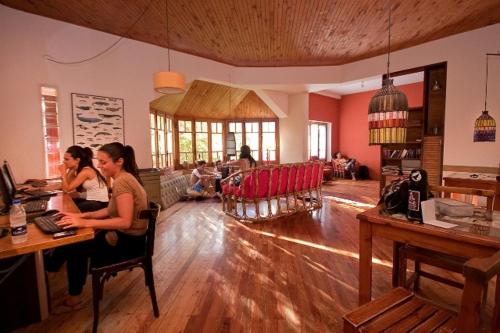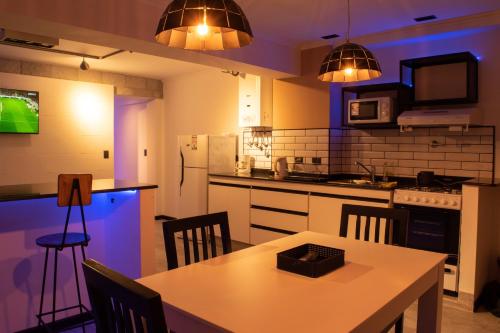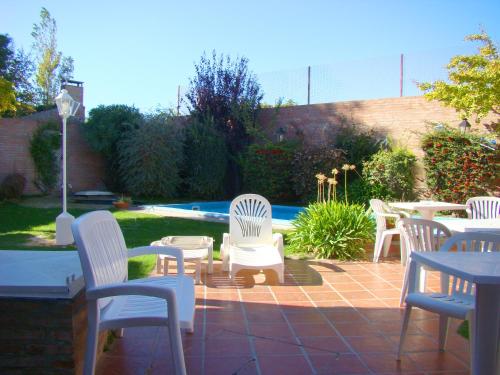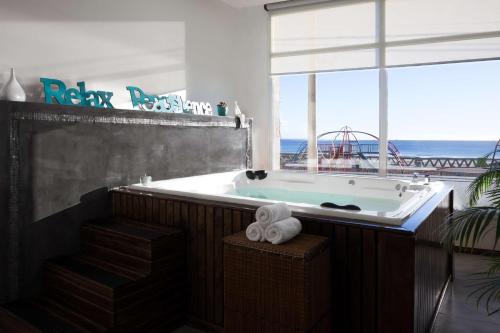Why is it so hot? I thought penguins were supposed to live in the cold, on snow, surrounded by icebergs.
Instead, they’re standing in the dunes, far from the water, in direct sunlight on a 40-degree day.
They’re panting in the heat. So am I. This is not what I expected from a penguin colony.
It’s not even like just a couple of them got confused and thought the Argentinian summer would be a nice break from the freezing temperatures of Antarctica.
There are more than one million penguins here at Punta Tombo, making it the largest colony in South America.
When can you see penguins at Punta Tombo?
The best time to see the penguins at Punta Tomba is during the breeding season, which normally runs from September to April each year. The chicks start to hatch around late October and so the best time to see chicks and adults is from December to February.
What type of penguins are at Punta Tombo?
Punta Tombo has South America’s largest colony of Magellanic penguins, which are also called South American penguins. They have black and white plumage with pink patches of skin around their eyes, and grow to about 70 centimetres high.
Is it worth visiting Punta Tombo?
As one of the top natural attractions in this part of Patagonia, it’s well worth visiting Punta Tombo to see the enormous penguin colony. However, getting to Punta Tombo takes quite a long time to reach, so there may be better things to do if you’re short of time. It’s also not worth visiting outside of breeding season, when there’s not much else to see.
Obviously, it’s not the penguins who are confused, but me. I guess I was expecting ‘Happy Feet’ but instead got ‘Floppy Heat’.
But there’s a good reason that visiting Punta Tombo is one of the most popular things to do in this part of Patagonia. It’s quite incredible to see so many penguins in the one spot, calmly hanging out on the beach, in the dunes, amongst the bushes… pretty much everywhere.
Unlike Peninsula Valdes, one of the other main natural attractions in the region, there isn’t a huge variety of animals to see here. And although the environment is pleasant, you don’t come here for the landscapes.
This is all about the Magellanic penguins, who come here for about half the year for the breeding season, the population more than doubling once the chicks hatch.
To arrange a trip to Punta Tombo, I recommend this shore excursion if you’re on a cruise, or this day trip if you’re staying in Puerto Madryn.
In a moment, I’ll share lots of tips that may be useful if you’re planning to visit Punta Tombo. But first, let’s have a look at why it’s such a significant site.
The penguins of Punta Tombo
This stretch of coastline – both up and also down around the bottom tip of South America – is the natural habitat of the Magellanic penguins, which are mainly found in Argentina and Chile, but also in Uruguay and Brazil.
The Magellanic penguins (named after explorer Ferdinand Magellan, who spotted them in 1520) are medium-sized, normally around 70 centimetres tall.
They have black backs and white fronts, with black bands (normally two) between their chest and head. Around their eyes, they often have exposed pink skin. And, of course, they have two webbed feet and two wings used for swimming instead of flying.
When it’s time to breed, the Magellanic penguins come together in large colonies. There are lots of them throughout South America, but Punta Tombo is the largest one by far.
The numbers fluctuate each year, but there are usually between 200,000 and 400,000 breeding pairs of penguins (so, between 400,000 and 800,000 adults). Each pair lays two eggs, so eventually the colony can have well over a million animals.
The breeding season starts in September as the penguins come in from months at sea and pair up (they’re monogamous so they normally find their usual partner in the same nest).
The eggs are laid in October or November, with the first hatching in late October. As they grow during December and February, the parents come and go from the sea to get food and the colony is very busy!
By March or April, the chicks have moulted into their adult plumage and are ready to head to sea, and gradually Punta Tombo empties as all the birds leave until the next breeding season.
Threats to the penguins
When it comes to raising the chicks, both parents share the duties. But in recent times, this arrangement has been threatening their very existence.
While one of the penguins swims out to sea to feed itself, the other takes on the domestic duties in the nest. The animal feeding in the ocean might be gone for quite a few days while it finds food and, in the meantime, its partner waits.
The problem is that climate change and overfishing has meant the food source has moved further away and the penguins have had to swim an extra 40 kilometres or so to feed.
The extra time away from the nest has meant the partner waiting sometimes dies from starvation, which means the chicks may too.
The Magellanic penguins are now listed as a ‘threatened species’. The population numbers are declining for several reasons – climate change being one of them.
Rising temperatures has led to an increasing number of extreme-heat days at Punta Tombo, on which hundreds of penguins might day from heat exhaustion or dehydration.
That doesn’t just been those animals are lost – it also means fewer breeding pairs in the coming years, which leads to a gradual decline in numbers (which is what researchers are unfortunately seeing).
The penguins here also face other threats to their colony, such as offshore drilling, plastic pollution, habitat destruction (outside of the protected area), and predators.
Thankfully, looking around during a visit to Punta Tombo, it’s hard to imagine they are under threat. It’s not so bad that it’s visible to the average visitor – there are literally hundreds of thousands of penguins as you walk through the colony.
They stand at the entrance to their nests, panting in the heat and watching you with a wary eye.
They gather in groups around puddles of water on the pathway.
They waddle from bush to bush looking confused and lost.
And they lie in the shade of shrubs as their feathers malt off ahead of the new season.
The penguins seem comfortable with the humans who walk around them and weave between their nests. They also seem mostly comfortable with the warmth of their surroundings.
How unfortunate that humans are creating a warmth on this planet that is killing many of these animals in a most uncomfortable way.
Visiting Punta Tombo
The first thing to know is that visiting Punta Tombo is seasonal. The penguins begin arriving in September to lay eggs, and then leave again in March or April.
It’s only worth visiting Punta Tombo between September and April, and you’ll need to check in advance that there will be enough penguins there at the start and the end of the season.
The best time to visit Punta Tombo is between December and February because that’s when you’ll have lots of adults and chicks to see.
The closest town of any significant size is Trelew, so this can work as a base if you’re travelling independently. There is a decent range of places to stay in Trelew, as well as a fair number of restaurants.
However, most independent travellers choose to base themselves in Puerto Madryn. It’s about the same size and further about from Punta Tombo. But it’s more of a tourist hub and also gives you convenient access to other attractions, particularly Peninsula Valdes.
From Trelew, the drive to Punta Tombo is about two hours, and it’s about 2h 40m from Puerto Madryn.
If you don’t have your own transportation, there are tours from Puerto Madryn that will take care of all the logistics.
One of the main tour companies does this good day trip to Punta Tombo. Or there’s also this longer day tour that visit some other beautiful natural sites in the Chubut region.
If you’re on a cruise that’s stopping at Puerto Madryn, a day trip to Punta Tombo is a popular option for a shore excursion.
As you know, the cruise lines charge a lot more for excursions than if you go direct to a local operator. To visit Punta Tombo, I would recommend this good shore excursion that will time the trip with the ship times.
Or there are some other good options here.
When you get out there, you’ll discover there are a few things to do at Punta Tombo.
The first is the Tombo Centre, which is a combined visitor centre and museum. It has some exhibitions here about the animals and the conservation efforts.
There’s also a small coffee shop and toilets.
From the Tombo Centre, you’ll be taken by shuttle bus to the beginning of the paths that go through the colony. (The shuttle bus is partly so the number of visitors can be regulated, so sometimes you’ll need to wait a bit.)
There are two walking routes that go amongst the penguins. The shorter one is 650 metres return. The longer one is 3.5 kilometres return. (They’re two-way paths, so you can just turn back whenever you want.)
Although Punta Tombo is a very popular tourist site and there is visitor infrastructure here, it’s still relatively remote and undeveloped. So it’s worth keeping these things in mind when you visit:
- If you’re driving, I recommend filling up with petrol because there are no service stations between Trelew and Punta Tombo (which is about a 250-kilometre return drive).
- Some parts of the walking path can be a bit uneven, so wear good shoes.
- It can get very hot here (above 40 degrees in summer) and there is not much shade – so definitely bring sun protection.
- Bring cash for the entrance fee because credit cards might not be accepted.
- If possible, visit early in the morning when it’s going to be less crowded and a cooler temperature.
Also, although this advice should be obvious, I’ll mention it anyway.
You’re not allowed to touch or pick up the penguins (even though they look cute and cuddly).
And it’s very important you stay on the paths, because there are nests everywhere and it’s very likely you’ll tread on them if you try to go your own way.
Where is Punta Tombo?
Punta Tombo is on the east coast of Argentina, in the Chubut province. It’s about 110 kilometres south of Trelew and 190 kilometres south of Puerto Madryn.
You can see it on a map here.
How do you get to Punta Tombo?
There is no public transport to Punta Tombo.
The easiest way to get to Punta Tombo is to drive. It’s about two hours from Trelew or 2h 40m from Puerto Madryn. There’s lots of parking available on site.
If you’re travelling independently, there are tours from Puerto Madryn (that usually also offer pick-up from Trelew).
When is Punta Tombo open?
Punta Tombo is open daily from 9:00 – 17:00.
The penguin season is from approximately September to April.
What is the Punta Tombo entrance fee?
The standard ticket for foreigners is AR$8500 (US$9.60) for adults and the concession is AR$4200 (US$4.75).
Children up to 5 years old are free.
Are there tours to Punta Tombo?
Yes, there are quite a few tours to Punta Tombo and they may actually be the easiest way for you to reach the site if you don’t have a car.
If you’re staying in Puerto Madryn or Trelew, I would recommend this day trip, which is one of the most affordable options.
If you’re on a cruise, then there’s this good shore excursion from Puerto Madryn that will be timed with the ship.
For more information, see the official website of Punta Tombo.
Of course, it’s Patagonia, so there are some other beautiful things to do in Chubut.
I definitely recommend visiting Peninsula Valdes, the region’s other main natural attraction and one of Argentina’s World Heritage Sites.
There’s also Playa Unión, where you can relax on the beach or take a boat trip from Puerto de Rawson to see Commerson’s dolphins.
For a nice place to stop for a rest, there’s Gaiman, a Welsh settlement known for its traditional tea houses.
And in Trelew, visit the Paleontological Museum, which showcases the region’s rich prehistoric past.
THE BEST ACCOMMODATION IN PUERTO MADRYN
Staying in Puerto Madryn makes a fantastic base to explore the natural wonders in this part of Argentina.
BACKPACKER

There’s a wonderful laidback atmosphere at El Gualicho Hostel, with a large common area, a lovely garden, and free breakfast.
APARTMENT

For space to yourself, Complejo las Catalinas is an affordable modern one-bedroom apartment in a great location.
BOUTIQUE

It may feel like a rustic house with its brick walls, but Los Tulipanes Apart de Mar is actually quite modern, and has a garden and pool.
LUXURY

Overlooking the beach, Dazzler by Wyndham is still close to the city centre and includes a delicious free breakfast.
Glad you made it here! One of my favorite memories from my travels 🙂
Yeah, I just loved walking around them. It’s so cool they way they just stand there and look at you.
Aww they’re so cute! It’s weird to see penguins not on snow! Great post.
It’s super weird to see them in such a hot climate.
Love this post! And love penguins! 🙂
How cute are they?! 🙂
Penguins are possibly the cutest animals ever, lovely shots!
It makes me really want to go and see the larger ones in Antarctica now! Oh well… maybe one year…
Oh I love penguins. And like you I also saw them in the heat for the first time… in Simon’s Town in South Africa… 😀
Oh, I hadn’t heard about the ones in South Africa. I’ll have to check it out sometime when I get there!
Oh, I’ve seen them in hot weather, too (at the zoo). They’re quite resilient in the wild though, I’ve always thought. But I’d also love to see them in person. I think they always act so well and cute with one another. What a great place to visit!
It’s quite funny to watch them pant in the heat. They’re not uncomfortable – it’s just the way they manage the temperature of their bodies. But you don’t expect it from penguins.
They are so cute!
Fun photos – makes me want to visit 😉
The best time of year is from about November to March, so try to fit it in to a trip south sometime!
i like the first pic.. that’s so cute… would love to see happy feet too.. hoping someday.. 😀
I know – the first pic looks like the penguin is just going for an afternoon stroll down the path. How cute!
So cute! Gorgeous pics! I want to see penguins too! Real ones, in their natural habitat!
This is a great way to see them in the wild. But it’s not the same as seeing them on the ice, I imagine.
So adorable! We love penguins.
And these ones were so cute!!
I thought those penguins looked familiar, and then when I saw they were from Punta Tombo in Argentina I knew we’d previously met.
Great photos!
Jared
Ha! Those penguins are just following you around the world!! 🙂
Hey! 🙂 Thanks for sharing this awesome pictures. Love to see the Happy Feets 🙂
All the best, Christoph
Thanks Christoph! I always smile when I look back at these photos! 🙂
former dinosaurs thank for your efforts to help these
Super Webseite, danke für diesen tollen Beitrag… werde hier auch in Zukunft zurückgreifen 😉 DANKE !!!! Liebe Grüße Mia